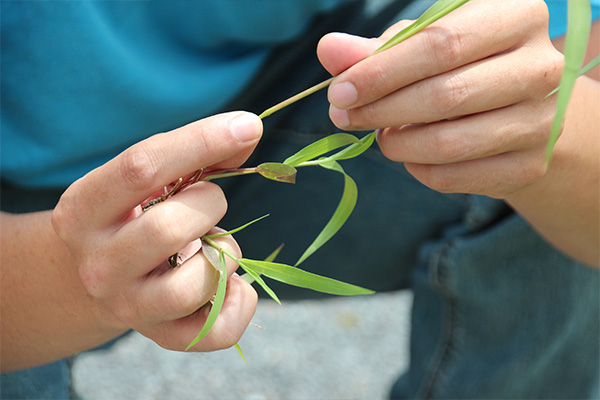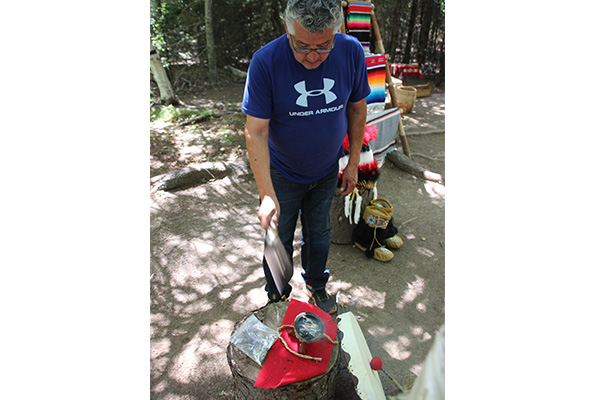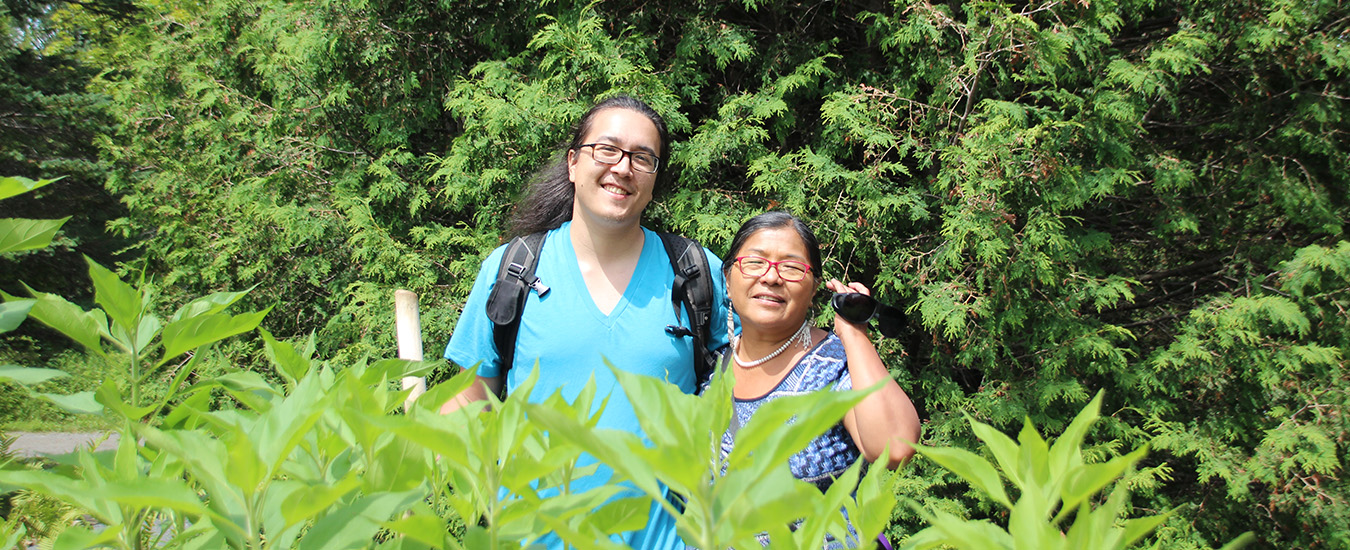“Adaptation is inherent to who we are,” says Cecilia Brooks
They called it white man’s footprints,” says Cecelia Brooks. “Wherever settlers would walk, we’d find plantain.” Brooks isn’t talking about the banana-like tropical fruit. She’s referring to a little plant we all know, but probably pay little attention. It’s that leafy green that grows very low to the ground, especially in poor soil. It thrives in my driveway where it produces spiky stalks of tiny seeds.
“This is an amazing plant,” Brooks continues. “Some people just wrap it right around a cut.” She and her son, Anthony Brooks run Wabanaki Tree Spirit Tours. Today, they’re guiding a small group on an Indigenous medicine walk at the 54-acre Fredericton Botanic Garden in New Brunswick. We’re starting at the new Wabanaki Healing Garden that sits at the edge of a field and a wooded area. Anthony Brooks and some friends researched, designed, and planted the garden of about 45 species in two concentric circles surrounded by gravel paths.
Cecilia Brooks says many people believe plantain arrived in North America with European settlers, but she thinks of its introduction and use by Indigenous people in much broader terms, placing the plant in the context of the known history of her people.
“Archeological evidence is showing 13,500 years,” she says. “That means we’ve been here since the time of the glaciers. Adaptation is something that’s inherent to who we are.” She says the same goes for the uses—medicinal and otherwise—her people have for plants, regardless of their origins. “It’s about adaptation. Even though it wasn’t from here, plantain became a part of our usage. Many of the plants that come from Europe became incorporated into our materia medica, our pharmacopoeia.”
These are terms unfamiliar to me, but I get the general idea. Both refer to collective pharmaceutical knowledge. What surprises me is that Brooks is using them at all. When I signed up for an Indigenous medicine walk, I expected talk of folk cures and traditional knowledge, not European plants and the Latin terms for them.

Sweetgrass in the Wabanaki Healing Garden
Anthony adds to this surprising conversation by telling us about a variety of plantain that is indeed native to North America. Pointing to one of several varieties he’s planted here—it’s pale purple at the stem—he says this is Rugel’s plantain (Plantago rugelii) named for the 19th century German-born botanist, pharmacist, doctor and farmer Ferdinand Rugle, who discovered and documented it in North America.
When I ask Cecelia about this fusing of traditional Indigenous knowledge and western scientific knowledge, she surprises me again, this time by telling me about Albert Marshall, an Indigenous elder from Cape Breton she and so many others have come to admire.
“He talks about the need to look at the world, not just from the scientific perspective, but also from the Indigenous perspective.” She says Marshall used a Mi’kmaq word to describe this way of knowing and was the first to translate it into English. He called it two-eyed seeing.
Origins of two-eyed seeing
All his life, Albert Marshall struggled to understand his childhood, most of which he spent at the Shubenacadie residential school. Forever after, he’s been on a quest to heal from that experience, to find a silver lining in that dark cloud. As a man shaped by two cultures—one robbed from him, one forced upon him—he has worked hard to find a path toward a personal and cultural reconciliation. He yearned for a reconnection with his Indigenous past and an understanding of both cultures, with the goal of achieving mutual respect for the good of all.
In 2004, Marshall used the Mi’kmaq word Etuaptmumk to encourage Indigenous students to study Western science while respecting traditional knowledge passed down through the generations in their communities. He translated the Mi’kmaq word as “two-eyed seeing.” Etuaptmumk is the gift of multiple perspectives, of the ability to look through one eye with the power of Indigenous ways of knowing and through the other with the power of Western science to reach full sight.
Some think of Marshall’s concept as another way to understand how the human brain works. An Indigenous worldview tends to favour the strengths of the brain’s right hemisphere—intuition, creativity, interconnectedness. The Western, science-based worldview favours the left hemisphere—logic, precision, objectivity. Those who can manage to merge these complementary, sometimes contradictory, strengths will achieve a vision that’s more complete.
As if he’d flipped a switch, Marshall’s introduction of two-eyed seeing immediately clicked with scientists, historians, artists, social workers, and bureaucrats across the country. The concept began showing up all over the place. Those working on the federal species-at-risk act, the treatment of addiction and diabetes, education in the north, astronomy, watershed health, arts in the community, and even concussion awareness in hockey began to apply two-eyed seeing to their research and practice. The concept is most widely adopted in Cape Breton where it originated with applications in everything from mental health services to economic development.

Junior Peter Paul with his Mi’kmaq display at Greenwich.
Practical applications
On PEI, there’s a particularly timely application of two-eyed seeing. The Mi’kmaw of Lennox Island are working with the School of Climate Change and Adaptation at the University of PEI to learn more about coastal erosion and sea level rise as it impacts their lands. Dr. Adam Fenech, the school’s associate dean, uses drones equipped with high tech sensors to create 3D images of coastal changes and to predict future impacts. One study conducted on PEI determined that the island lost some 5,000 acres of coastal land in the past 50 years. Places like Lennox Island are far more susceptible than others to such losses.
As Fenech and UPEI open a new $16 million climate change centre in St. Peter’s near PEI National Park, he and his students are deploying over 100 climate stations and 17 tidal stations across the island to gather temperature, wind speed, solar radiation and sea level data. This work is being carried out in conjunction with Parks Canada, the PEI Emergency Measures Organization, and the Mi’kmaq Confederacy of PEI.
As I walked the national park coastline near the new centre with Fenech last summer, he told me how he incorporates two-eyed seeing into his work, starting with his scholarly papers on the concept as it applies to climate change. “Western science can provide certain information, but traditional knowledge needs to be there as well.”
He believes people are excellent climate instruments. While they provide very different information than the sensors on his drones, both are necessary to generate a full picture. “Whenever anybody says we need to look at the historical record to do a climate impact assessment, and they say we don’t have any instruments, I say you’ve got all these human beings here. Let’s ask them.”
Medical research
The authors of a 2021 paper published in the British Columbia Medical Journal set out to determine if medical researchers are incorporating a two-eyed seeing approach into their work. “Emotional, spiritual, and physical relationships with the natural world influence traditions and customs,” they reported. “Ties to the natural world also influence perspectives on research.”
When it comes to conducting medical research that serves Indigenous people, the authors concluded that researchers have to spend time in Indigenous communities. “Research with Indigenous populations requires taking time to create a trusted, respectful, and ethical friendship in which problems can be identified and approached together, rather than based on a Western view of researchers coming into a community to solve their problems for them.”
By the end of the day with Cecelia and Anthony Brooks, the mother and son have talked about plants and phytoestrogens, anthocyanin and analgesics, while referring to sweetgrass used in smudging ceremonies as Hierochloe odorata.
“Next spring, there will be signage here so each plant will have an identification tag with the Latin binomial, Mi’kmaq and Maliseet words, habitats and uses,” Cecelia says.
Anthony points out some cow parsnip he planted and says it has an edible tuber. Because it resembles poisonous plants like giant hogweed, he’s very careful when harvesting, often waiting until after frost has killed the dangerous leaves.
Cecelia adds that, according to Indigenous oral history, cow parsnip also has medicinal properties. Elders told her that it became a folk treatment for the Spanish flu a century ago. “Recently, a group of grad students at UNB Saint John were testing it,” she says. “It was very effective in a Petri dish.
They found it killed the flu virus.”
That research, she says, was inspired by stories of its use in that pandemic. “We knew it was true. Now, there’s science to corroborate the Indigenous knowledge.” As we near the end of another pandemic, it seems we all stand to gain by placing traditional medicine alongside Western science.
